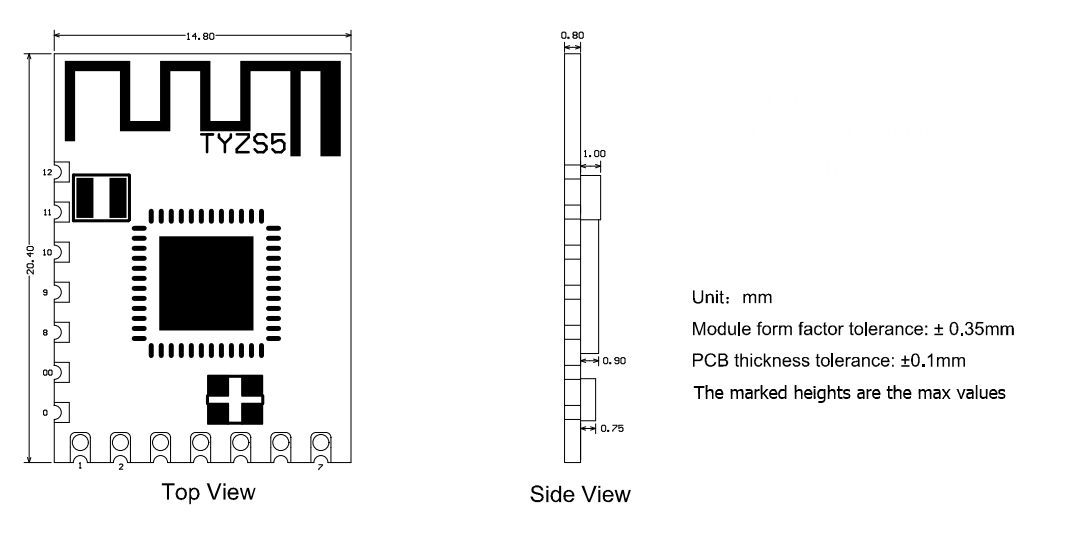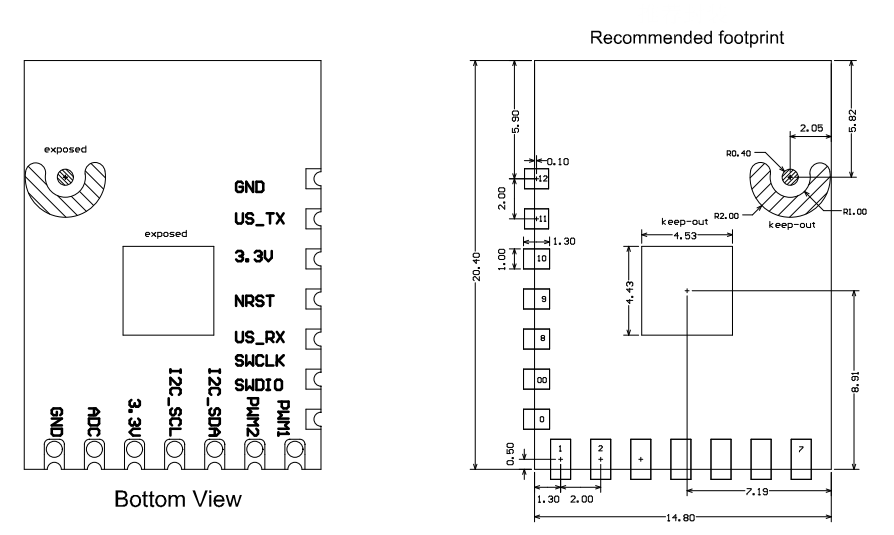TYZS5 Module Datasheet
Last Updated on : 2024-06-14 03:09:02download
TYZS5 is a low power-consumption embedded Zigbee module developed by Tuya. It consists of a highly integrated wireless RF processor chip (EFR32MG13P732F512GM48) and several peripherals. TYZS5 is embedded with a low power-consumption 32-bit ARM Cortex-M4 core, 512-KB flash memory, 64-KB RAM, and rich peripheral resources.
Overview
TYZS5 is a silicon module that can be used to develop Zigbee applications. In terms of hardware, it has PA and DC-DC. In terms of software, it can provide complete basic APIs for Zigbee. Based on this, users can develop embedded Zigbee products as required.
Features
- Built-in with the low-power 32-bit ARM Cortex-M4 processor, have a DSP instruction set and a floating-point unit, and can also work as an application processor
- Clock rate: 40MHz
- Wide operating voltage: 2.2V-3.8V
- Peripherals: 6 GPIOs, 1 UART, and 1 ADC
- Zigbee operating characteristics
- Supports 802.15.4 MAC/PHY
- Operating channels 11 to 26 @2.400-2.483GHz, air-interface rate 250Kbps
- Built-in DC-DC circuit for maximum power efficiency
- Maximum output power of +19dBm
- 63μA/MHz operating power consumption; 1.4 μA sleep current
- Built-in PCB onboard antenna
- Operating temperature: -40℃ to 85℃
- Supports hardware encryption and supports AES 128/256
Application
- Smart buildings
- Smart homes/appliances
- Smart plugs and smart lighting
- Industrial wireless control
- Health and measurements
- Asset tracking
Change history
| Change date | changed content | Version after the change |
|---|---|---|
| 2018.5.22 | First release | V1.0.0 |
| 2018.12.10 | Updated the serial port in the production test mode and updated serial port docking instructions | V1.0.1 |
| 2019.7.23 | Updated power consumption, storage conditions, and soldering temperature curve. | V2.0.0 |
| 2019.12.19 | Added description on I/O pins | V2.0.1 |
| 2021.3.4 | Updated the production instructions | V2.0.2 |
| 2021.6.2 | Updated the MOQ and packaging information | V2.0.3 |
| 2022.7.29 | Updated Baking parameters | V2.0.4 |
Module interfaces
Dimensions and footprint
TYZS5 has 2 lines of pins, 14 pins in total. There is a spacing of 2mm between pins.
TYZS5 dimensions: 14.8±0.35mm (W) x 20.4±0.35mm (L) x 1.8±0.15mm (H).
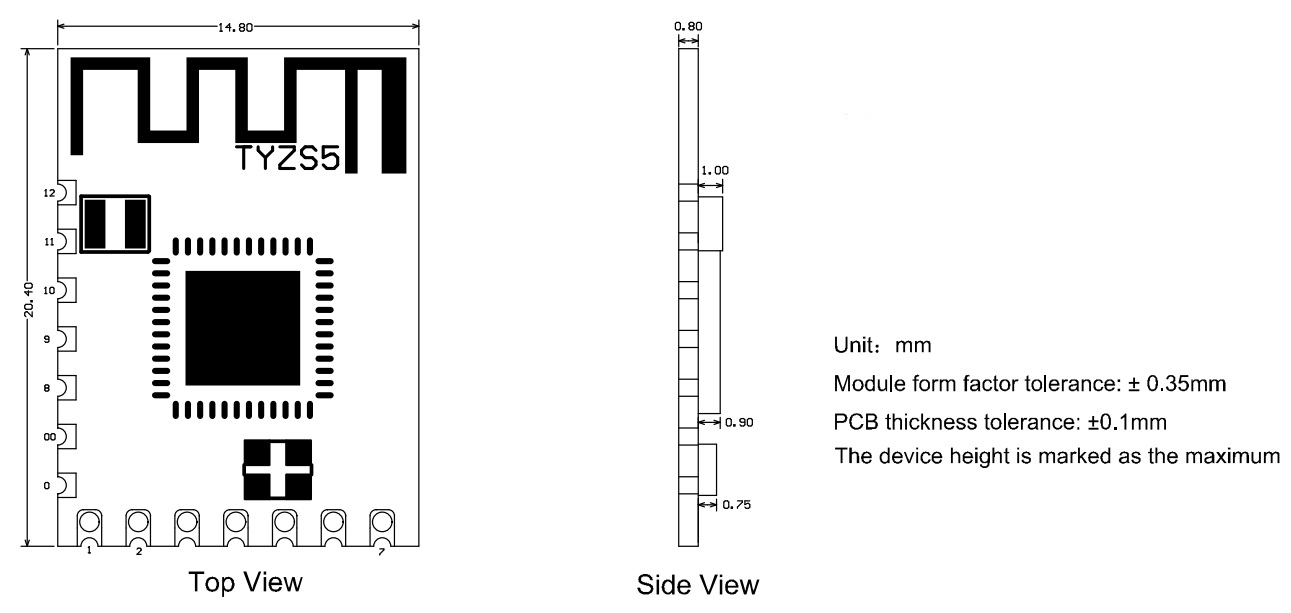
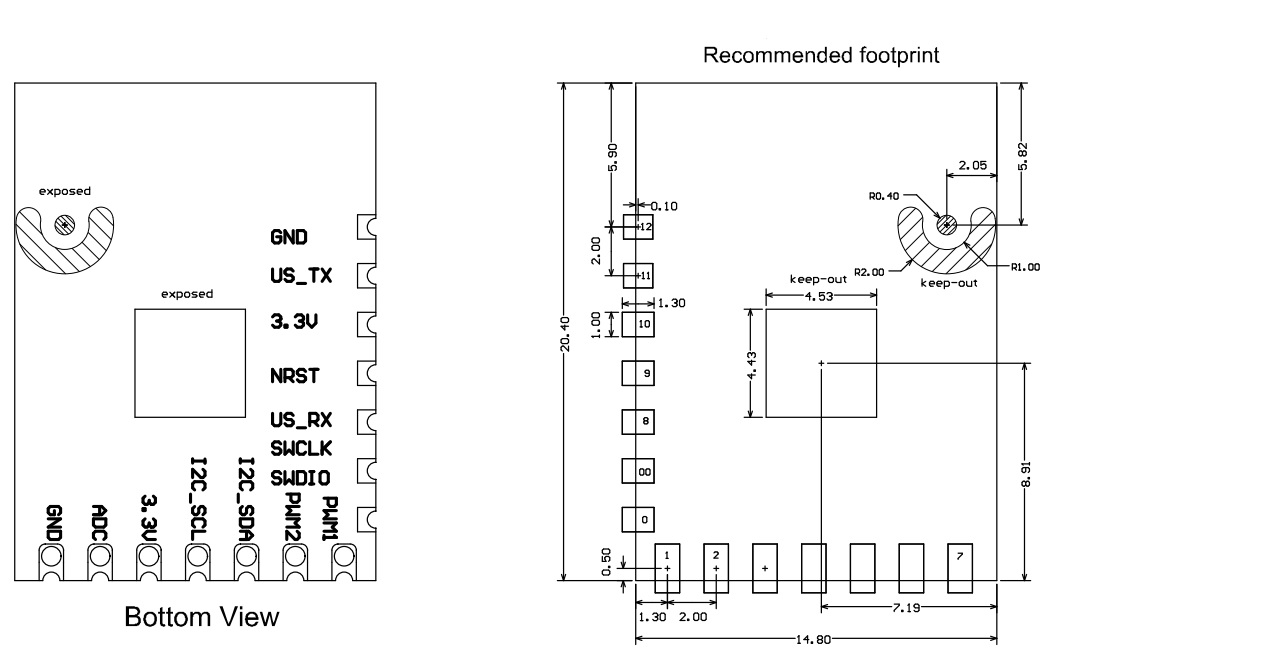
The layout of pins of TYZS5:
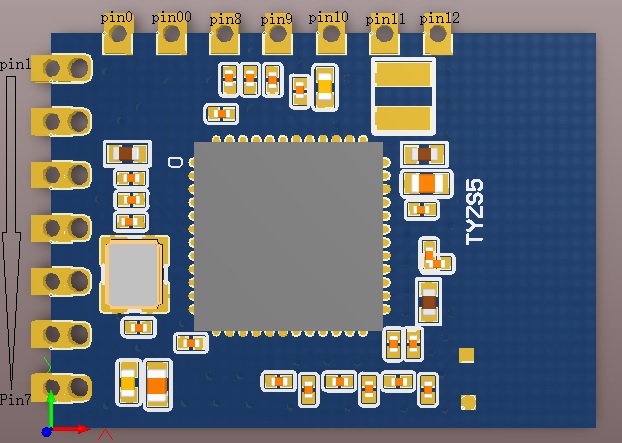
Pin definition
The pins are defined in the following table:
| Pin number | Symbol | IO type | Function |
|---|---|---|---|
| 1 | PWM1 | I/O | Light driver port/GPIO pin usage. |
| 2 | PWM2 | I/O | Light driver port/GPIO pin usage. |
| 3 | I2C_SDA | I/O | I2C_SDA, GPIO pin usage. |
| 4 | I2C_SCL | I/O | I2C_SCL, GPIO pin usage. |
| 5 | VCC | P | Module power supply pin (common supply voltage: 3.3V) |
| 6 | ADC | AI | ADC, 12-bit precision SAR analog to digital converter |
| 7 | GND | P | The reference ground of the module. |
| 0 | SWDIO | I/O | JLINK SWDIO programming pin. Can be used as a GPIO pin in normal applications. |
| 00 | SWCLK | I/O | JLINK SWCLK programming pin. Can be used as a GPIO pin in normal applications. |
| 8 | RXD | I/O | UART0_RXD, RX serial port. |
| 9 | nRST | I | Hardware reset pin, the chip is reset when the pin is LOW; Power-on reset of the module, the user can use this pin as needed. |
| 10 | VCC | P | Module power supply pin (common supply voltage: 3.3V); Since there is an internal connection to the 3.3V network, no external handling is necessary. |
| 11 | TXD | O | UART0_TXD, TX serial port. |
| 12 | GND | P | The reference ground of the module is internally connected to GND and does not need to be handled externally. |
Note:
- P indicates the power pin; I/O indicates the input/output pin; AI indicates the analog input pin.
- The nRST is only the module hardware reset pin; it cannot clear Zigbee net-pairing information.
- (1): This pin can only be used as an ADC port. It cannot be used as a normal IO port. If it is not used, it needs to be left floating.
- As an ADC input, the input voltage range is limited to 0-AVDD and can be configured by software.
When TYZS5 is used as a gateway module, the pins are connected as follows:
| Pin name printed on the module | Corresponding pin name when used as gateway module | Pin of the internal IC | Remarks |
|---|---|---|---|
| PWM1 | UART_CTS | PA4 | The coordinator used for the gateway must be connected to hardware flow control by default. The baud rate is 115200. The pin is connected to UART_RTS of the MCU. |
| PWM2 | UART_RTS | PA3 | The coordinator used for the gateway must be connected to hardware flow control by default. The baud rate is 115200. The pin is connected to UART_CTS of the MCU. |
| UART_RX | UART_RX | PA1 | Pin 4, which is connected to UART_TX of the MCU. |
| UART_TX | UART_TX | PA0 | Pin 3, which is connected to UART_RX of the MCU. |
| nRST | nRST | RST | The pin is connected to the GPIO of the MCU, and the GPIO is at high level by default. |
Definitions of test pins
TYZS5 has no special test points exposed outside.
Electrical parameters
Absolute electrical parameters
The following table describes the absolute parameters.
| Parameters | Description | Minimum value | Maximum value | Unit |
|---|---|---|---|---|
| Ts | Storage temperature | -50 | 150 | ℃ |
| VCC | Input voltage | -0.3 | 3.8 | V |
| Electrostatic discharge voltage (human body model) | TAMB-25℃ | - | 2.5 | KV |
| Electrostatic discharge voltage (machine model) | TAMB-25℃ | - | 0.5 | KV |
Operating conditions
The following table describes the normal operating conditions.
| Parameters | Description | Minimum value | Typical value | Maximum value | Unit |
|---|---|---|---|---|---|
| Ta | Operating temperature | -40 | - | 85 | ℃ |
| VCC | Operating voltage | 2.2 | 3.3 | 3.8 | V |
| VIL | IO low input | -0.3 | - | VCC*0.25 | V |
| VIH | IO high input | VCC*0.75 | - | VCC | V |
| VOL | IO low output | - | - | VCC*0.1 | V |
| VOH | IO high output | VCC*0.8 | - | VCC | V |
| Imax | IO drive current | - | - | 12 | mA |
Zigbee TX power consumption
The following table describes the power consumption during continuous TX.
| Symbol | Rate | Transmission power | Typical value | Unit |
|---|---|---|---|---|
| IRF | 250Kbps | +19dBm | 118 | mA |
| IRF | 250Kbps | +10dBm | 32 | mA |
| IRF | 250Kbps | +4dBm | 17 | mA |
| IRF | 250Kbps | +1dBm | 11.8 | mA |
Note: When testing the above data, the continuous transmission duty cycle=100%.
Zigbee RX power consumption
The following table describes the power consumption during continuous RX.
| Symbol | Rate | Typical value | Unit |
|---|---|---|---|
| IRF | 250Kbps | 8 | mA |
Note: When UART is active, the RX mode current is 8mA.
Power consumption in operating mode
The following table describes the TYZS5 operating current.
| Operation mode | Operating condition, Ta=25℃ | Average value | Maximum value (Typical) | Unit |
|---|---|---|---|---|
| Quick configuration | Module in quick configuration state | 10 | 40 | mA |
| Network connection state | Connected to a network | 1 | 23 | mA |
| Deep sleep mode | Deep-sleep mode and retains 64KB RAM | 3.5 | 5 | μA |
RF characteristics
Basic RF characteristics
The following table describes the basic RF characteristics.
| Parameter | Description |
|---|---|
| Operating frequency | 2.400 to 2.484GHz |
| Physical layer standard | IEEE 802.15.4 |
| Data transfer rate | 250Kbps |
| Antenna type | PCB antenna |
| Line of sight | >100m |
Zigbee output performance
The following table describes the continuous TX performance.
| Parameter | Minimum value | Typical value | Maximum value | Unit |
|---|---|---|---|---|
| Maximum output | - | +19 | - | dBm |
| Minimum output | - | -30 | - | dBm |
| Output power adjustment step | - | 0.5 | 1 | dB |
| Frequency error | -15 | - | +15 | ppm |
| Output adjacent channel suppression | -31 | dBc |
Zigbee RX sensitivity
The following table describes the RX sensitivity.
| Parameter | Minimum value | Typical value | Maximum value | Unit |
|---|---|---|---|---|
| PER<10%, RX sensitivity, 250Kbps@OQPSK | - | -101 | - | dBm |
Antenna signal
Antenna type
Default PCB onboard antenna connection.
Antenna interference reduction
To optimize the Zigbee performance of the wireless module in combination with the PCB onboard antenna, it is recommended to keep the antenna at least 15mm from other metal parts.
The user PCB board should not be routed around the antenna area and should not be covered with copper to avoid affecting the antenna radiation performance. It is recommended that the adapter board antenna area be hollowed out.
For the module, PCB onboard antenna area refers to the TYZS5 mechanical dimensional figure below.
Packaging information and production guidance
Mechanical dimensions
Recommended PCB footprint
The diagram of pin wiring:

Note: Pin3/Pin4 is used by I2C communication or GPIO by default and can also be configured as a UART communication port using the software. Pin0/Pin00 is the JLINK programming interface. It can also be used as a normal I/O port in applications after burning in the program. The default configuration of Pin8/Pin11 is the UART communication port.
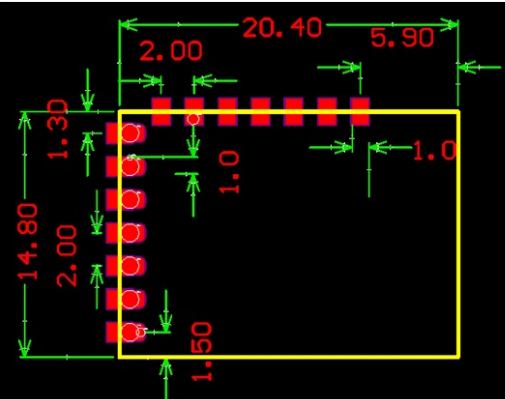
Production instructions
-
The Tuya SMT module should be mounted by the SMT device. After being unpacked, it should be soldered within 24 hours. Otherwise, it should be put into the drying cupboard where the RH is not greater than 10%; or it needs to be packaged under vacuum again and the exposure time needs to be recorded (the total exposure time cannot exceed 168 hours).
- SMT devices:
- Mounter
- SPI
- Reflow soldering machine
- Thermal profiler
- Automated optical inspection (AOI) equipment
- Baking devices:
- Cabinet oven
- Anti-electrostatic and heat-resistant trays
- Anti-electrostatic and heat-resistant gloves
- SMT devices:
-
Storage conditions for a delivered module:
- The moisture-proof bag must be placed in an environment where the temperature is below 40°C and the relative humidity is lower than 90%.
- The shelf life of a dry-packaged product is 12 months from the date when the product is packaged and sealed.
- There is a humidity indicator card (HIC) in the packaging bag.

-
The module needs to be baked in the following cases:
- The packaging bag is damaged before unpacking.
- There is no HIC in the packaging bag.
- After unpacking, circles of 10% and above on the HIC become pink.
- The total exposure time has lasted for over 168 hours since unpacking.
- More than 12 months have passed since the sealing of the bag.
-
Baking settings:
- Temperature: 40°C and ≤ 5% RH for reel package and 125°C and ≤5% RH for tray package (please use the heat-resistant tray rather than plastic container)
- Time: 168 hours for reel package and 12 hours for tray package
- Alarm temperature: 50°C for reel package and 135°C for tray package
- Production-ready temperature after natural cooling: < 36°C
- Re-baking situation: If a module remains unused for over 168 hours after being baked, it needs to be baked again.
- If a batch of modules is not baked within 168 hours, do not use the wave soldering to solder them. Because these modules are Level-3 moisture-sensitive devices, they are very likely to get damp when exposed beyond the allowable time. In this case, if they are soldered at high temperatures, it may result in device failure or poor soldering.
-
In the whole production process, take electrostatic discharge (ESD) protective measures.
-
To guarantee the passing rate, it is recommended that you use the SPI and AOI to monitor the quality of solder paste printing and mounting.
Recommended oven temperature curve
Perform mounting with the SMT based on the following reflow oven temperature curve. The highest temperature is 245°C. The reflow temperature curve is as below:

-
A: Temperature axis
-
B: Time axis
-
C: Liquidus temperature: 217 to 220°C
-
D: Ramp-up slope: 1 to 3°C/s
-
E: Duration of constant temperature: 60 to 120s; the range of constant temperature: 150 to 200°C
-
F: Duration above the liquidus: 50 to 70s
-
G: Peak temperature: 235 to 245°C
-
H: Ramp-down slope: 1 to 4°C/s
Note: The above curve is just an example of the solder paste SAC305. For more details about other solder pastes, please refer to Recommended oven temperature curve in the solder paste specifications.
Storage conditions
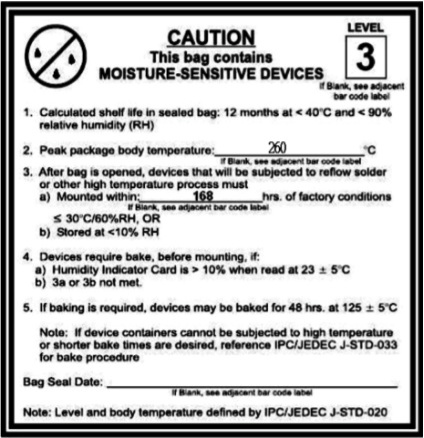
MOQ and packaging information
| Product model | MOQ (pcs) | Shipping packaging method | The number of modules per reel | The number of reels per carton |
|---|---|---|---|---|
| TYZS5 | 6000 | Tape reel | 1500 | 4 |
Appendix: Statement
FCC Caution: Any changes or modifications not expressly approved by the party responsible for compliance could void the user’s authority to operate this equipment.
This device complies with Part 15 of the FCC Rules. Operation is subject to the following two conditions: (1) This device may not cause harmful interference, and (2) this device must accept any interference received, including interference that may cause undesired operation.
Note: This equipment has been tested and found to comply with the limits for a Class B digital device, pursuant to part 15 of the FCC Rules. These limits are designed to provide reasonable protection against harmful interference in a residential installation. This equipment generates, uses, and can radiate radio frequency energy and, if not installed and used in accordance with the instructions, may cause harmful interference to radio communications. However, there is no guarantee that interference will not occur in a particular installation. If this equipment does cause harmful interference to radio or television reception, which can be determined by turning the equipment off and on, the user is encouraged to try to correct the interference by one or more of the following measures:
- Reorient or relocate the receiving antenna.
- Increase the separation between the equipment and receiver.
- Connect the equipment into an outlet on a circuit different from that to which the receiver is connected.
- Consult the dealer or an experienced radio/TV technician for help.
Radiation Exposure Statement
This equipment complies with FCC radiation exposure limits set forth for an uncontrolled rolled environment. This equipment should be installed and operated with a minimum distance of 20cm between the radiator and your body.
Important Note
This radio module must not be installed to co-locate and operating simultaneously with other radios in the host system except in accordance with FCC multi-transmitter product procedures. Additional testing and equipment authorization may be required to operate simultaneously with other radios.
The availability of some specific channels and/or operational frequency bands are country dependent and are firmware programmed at the factory to match the intended destination. The firmware setting is not accessible by the end-user.
The host product manufacturer is responsible for compliance to any other FCC rules that apply to the host not covered by the modular transmitter grant of certification. The final host product still requires Part 15 Subpart B compliance testing with the modular transmitter installed.
The end-user manual shall include all required regulatory information/warning as shown in this manual, including: This product must be installed and operated with a minimum distance of 20 cm between the radiator and user body.
The RF module is considered as a limited modular transmitter according to FCC rules. Even though the RF module gets an FCC ID, the host product manufacturer can not use the FCC ID on the final product directly. In these circumstances, the host product manufacturer integrator will be responsible for re-evaluating the end product (including the transmitter) and obtaining the FCC authorization by a Class II permissive change application or a new application.
Declaration of Conformity European notice

Hereby, Hangzhou Tuya Information Technology Co., Ltd declares that this module product is in compliance with essential requirements and other relevant provisions of Directive 2014/53/EU,2011/65/EU. A copy of the Declaration of conformity can be found at https://www.tuya.com

This product must not be disposed of as normal household waste, in accordance with the EU directive for waste electrical and electronic equipment (WEEE-2012/19/EU). Instead, it should be disposed of by returning it to the point of sale, or to a municipal recycling collection point.
The device could be used with a separation distance of 20cm to the human body.
Is this page helpful?
YesFeedbackIs this page helpful?
YesFeedback

